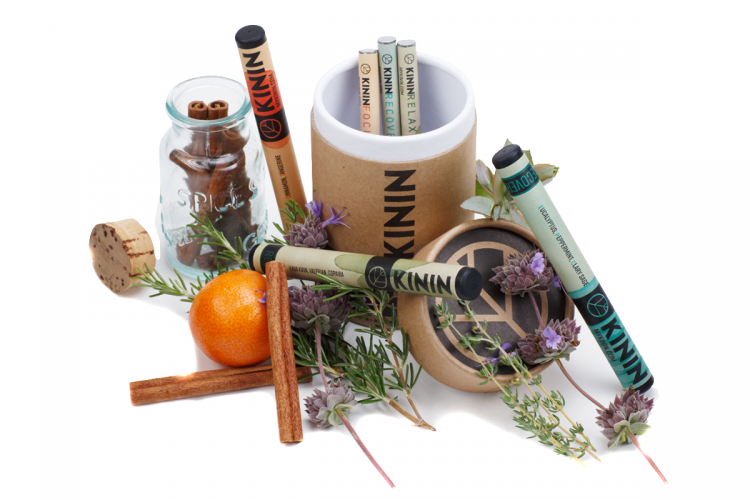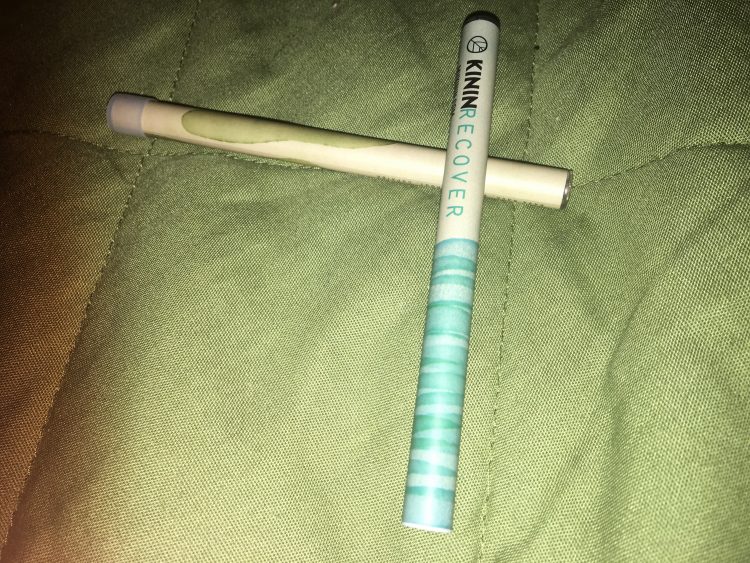I have a love/hate relationship with essential oils. I know they can be soothing and relaxing, but often, when they’re running through a diffuser for a long time, I get a headache. We were offered the chance to review the KININ personal aromatherapy pens, which have a different approach to aromatherapy, so I thought it was worth a shot!
KININ is very different from a regular diffuser. It, well, looks just like an e-cigarette, though the company is very quick to swear up and down that it is NOT an e-cig. You do put it in your mouth, though, draw in a vapor, but instead of inhaling it down your lungs, you exhale it out your nose. According to KININ, this helps with the efficacy of the aromatherapy:
KININ products push the envelope by combining Ayurvedic breathing techniques with essential oil blends that are designed to help our customers focus more easily, relax, and recover from physical or environmental strain. We meticulously design and craft highly specialized vaporizable liquids that contain no addictive substances (nicotine or otherwise) and are designed to fit into today’s active lifestyles and busy schedules.
There are three blends available now: Focus (nootropics [note that KININ does not say what these are made of], tangerine, and cinnamon), Relax (kava, valerian root, and copaiba), and Recovery (eucalyptus, peppermint, and clary sage). All of them are mixed with kosher vegetable glycerin, and while they don’t generate huge clouds of vapor, you may see some when you exhale.
Focus was by far my least favorite, as the tangerine flavor was just too harsh for my taste; it also made everything taste like tangerines and cinnamon for a while. Relax was nice in small doses, but Recovery was downright delicious. It was my go-to during the review period, and I found it to be refreshing and soothing. The mint flavor wasn’t overpowering, but it was pleasant and left a nice lingering sensation behind.
Now, did they work as intended? Focus left me jittery, but Relax did help me sleep, and Recovery seemed soothing enough. It’s tough to say how much of this was a placebo effect and how much was the true effect of the essential oils, but I think there was definitely some impact. The forced breathing in through the mouth and out through the nose is also soothing and helpful, even without the diffuser/vape component, but the oils probably help too. Also, I really love that none of the smells lingered. It kept the scents from becoming too overpowering, plus it made the experience more discreet. I could diffuse/vape and not worry about it stinking up my room or car for hours.
Of the three that were sent, I think I have reached for Recovery the most. It is soothing, and I’ve found that using it in the morning and at night seems to reduce my anxiety. However, I can’t say how much of that is from the oils and how much is simply the ritual of inhaling and exhaling.
KININ is very emphatic that these are not vapes in the traditional sense:
In pretty much every way. The only similarity is that a liquid is being vaporized. KININ products do not contain any nicotine, propylene glycol, or artificial flavors. They’re all natural.
They claim the delivery method is the only similarity, but I don’t buy that. For one thing, they look like e-cigarettes. Also, the tip lights up when you inhale. Finally, you’re bringing a tubular object to your mouth, inhaling and exhaling vapor. If it walks like a duck, talks like a duck, and smells like a duck … it’s probably not a bear.
I am not well versed in the legalese of vaping, but I am willing to guess that regulations have a lot to do with this; anything vape-related has to be 18+ and is under a different level of scrutiny than a “personal essential oil diffuser.” Still, I think the most telling part is this: I won’t use the KININ devices in front of my son because it looks far too much like I am smoking. Likewise, I highly doubt my office manager would be cool with me using KININ in my office because, again, it looks like smoking.
They say it is different, and that might well be the case, but they made a choice to design it the same as an e-cigarette in size, dimensions, and style; it looks exactly like the disposable e-cigs sold in convenience stores and gas stations. As an analogy, this would be like me driving a Vespa down the highway. If I got pulled over without a motorcycle license, I would still get a ticket, even if I tried to argue a Vespa wasn’t the same as a motorcycle. That’s how I see the KININ — it’s not necessarily as powerful as a vape, but you can’t really claim with a straight face that it isn’t under the same category.
KININ also claims their ingredients set them apart because they only use kosher vegetable glycerin and specially sourced oils. Cheap vape oils can contain controversial ingredients like propylene glycol. However, KININ isn’t unique in this respect. A very quick Google search led me to a number of higher-end e-liquids that are just organic vegetable glycerin and one or two identifiable flavors (for example, Kind Juices sells e-liquid that only contains vegetable glycerin and flavor, plus they provide a third-party lab test proving there is not any Diacetyl or other dangerous contaminants). They are not essential oils, but in terms of a “cleaner” vapor, KININ isn’t completely unique.
KININ is also pricey. One stick is $24, though that drops to $21.60 on “subscribe and save.” You can buy all three as a set for $60 or $54 on “subscribe and save.” That’s … not cheap, even though KININ says they can last around a month (or 250-300 breaths). A bottle of e-juice for a vape might run you about the same ~$25, plus the cost of the vape, but you get more flavor choices with a vape. On the other hand, KININ is one of very few companies selling inhalable essential oils, so if that is specifically what you want, well, you have no choice on the price.
So this where the review leaves me feeling a little mixed. On the one hand, I genuinely enjoy using the product and found that it helped my mental well-being. On the other hand, I can’t rule out a placebo effect or that breathing is the key over the oils. Most importantly, I am deeply uncomfortable with calling this a “personal essential oil diffuser” — it is a device that vapes essential oils. KININ can try to argue there is a difference, but it’s a vape in terms of looks and functionality.
Source: Manufacturer provided review model
What I Liked: Relaxing experience to use them; No learning curve; Recovery, in particular, is extremely pleasant to use; Scents only seem to impact the end-user and do not linger on clothes or in the area
What Needs Improvement: It’s a vape. Just call it that; Pricey; While portable, probably can’t be used anywhere vapes are banned
DISCLAIMER:
The statements made regarding these products have not been evaluated by the Food and Drug Administration. The efficacy of these products has not been confirmed by FDA-approved research. These products are not intended to diagnose, treat, cure or prevent any disease. All information presented here is not meant as a substitute for or alternative to information from healthcare practitioners. Please consult your healthcare professional about potential interactions or other possible complications before using any product. The Federal Food, Drug, and Cosmetic Act requires this notice.
Vaping products are only intended for sale to adults 21 years or older. The reviews and information posted on this site are not intended to be used as a substitute for professional health or medical advice and/or information, as no two people are alike. You and your doctor know your body best, and you should always get professional advice that is specific to you before trying any of the suggested actions, solutions, remedies, or instructions found on this site. The owners, editors, contributors, administrators, and other staff of Gear Diary LLC and Gear Diary are not qualified medical professionals, and the materials presented here are not intended to be nor do they constitute actionable professional advice.




